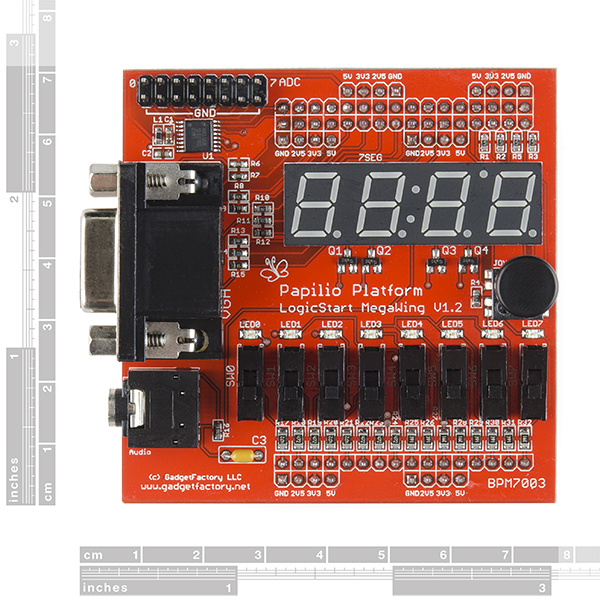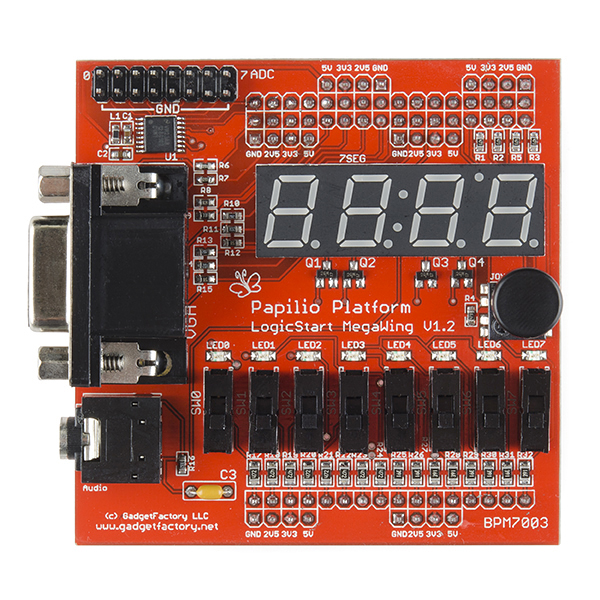Papilio - LogicStart MegaWing
The LogicStart is an open source MegaWing for the Papilio Pro development platform that provides you with everything you need to get started with VHDL (VHSIC [Very-High-Speed Integrated Circuits] Hardware Description Language) and FPGA development. This is the perfect MegaWing if you are just starting out with FPGA. Once paired with your Papilio board, the Logic Start provides you with many ammenities for experimenting and learning about FPGA development!
MegaWings are FPGA add-ons that plug straight into a Papilio Pro board and provide everything needed for a specific application in one convenient PCB. Since this LogicStart is a MegaWing it won't work on it's own so make sure you have, or pick up a Papilio Pro, if you want to learning how to develop in an FPGA or VHDL environment.
The LogicStart MegaWing comes equipped with a VGA video port, a seven segment display, 1/8th" mono audio jack, a 5-way micro joystick, an SPI ADC with an ADC128S102 IC, and 8 slide switches with status LEDs. If you are looking for a little help with your new FPGA the LogicStart MegaWing is a great place to begin!
- 7 Segment Display - 4 Character
- VGA Port - 3r,3g,2b VGA Output
- Mono Audio Jack - 1/8" Jack, Low Pass Filter, Delta Sigma DAC
- Micro-Joystick - 5 directions
- SPI ADC - 12-bit, 1Msps, 8 Channel
- 8 LED's - User Feedback
- 8 Slide Switches - User Input
- [Schematic](http://cdn.sparkfun.com/datasheets/Dev/FPGA/BPM7003 LogiStart MegaWing 2.1.pdf)
- [Eagle Files](http://cdn.sparkfun.com/datasheets/Dev/FPGA/BPM7003 LogiStart MegaWing 2.1.zip)
- Datasheet (ADC128S102)
- Intro to Spartan FPGA by Mike Field
- Downloads
- Product Page
- Product Video
- GitHub
Papilio - LogicStart MegaWing Product Help and Resources
Core Skill: Programming
If a board needs code or communicates somehow, you're going to need to know how to program or interface with it. The programming skill is all about communication and code.
Skill Level: Competent - The toolchain for programming is a bit more complex and will examples may not be explicitly provided for you. You will be required to have a fundamental knowledge of programming and be required to provide your own code. You may need to modify existing libraries or code to work with your specific hardware. Sensor and hardware interfaces will be SPI or I2C.
See all skill levels
Core Skill: Electrical Prototyping
If it requires power, you need to know how much, what all the pins do, and how to hook it up. You may need to reference datasheets, schematics, and know the ins and outs of electronics.
Skill Level: Rookie - You may be required to know a bit more about the component, such as orientation, or how to hook it up, in addition to power requirements. You will need to understand polarized components.
See all skill levels
Comments
Looking for answers to technical questions?
We welcome your comments and suggestions below. However, if you are looking for solutions to technical questions please see our Technical Assistance page.
Customer Reviews
No reviews yet.





About the only negative thing I can say about this nice board is that it was poorly washed by the manufacturer. It was quite sticky with flux residue, enough to make me clean it before using it. Intro to Spartan FPGA follows the Papilio One + LogicStart so closely that it makes it super easy to follow along. If you run into an issue with the first project not displaying anything on the LEDs, remember to SAVE and CLOSE your constraints file before synthesizing. Xilinx will happily synthesize and implement your design without actually using your constraints file, meaning that your inputs/outputs will not be on the right pins.
The pin mapping for use with the Papilio One and Papilio Pro can be found on http://papilio.cc/index.php?n=Papilio.LogicStartMegaWing
A few things to remember about addons to the Papilio that many people over look.
To the Catalog Monkey. Please make a link to the UCF file provided for the wing.
We try not to link to files that will be changed and revisioned. the UCFs will change over time, making our links outdated. I was able to download them without issue at all.